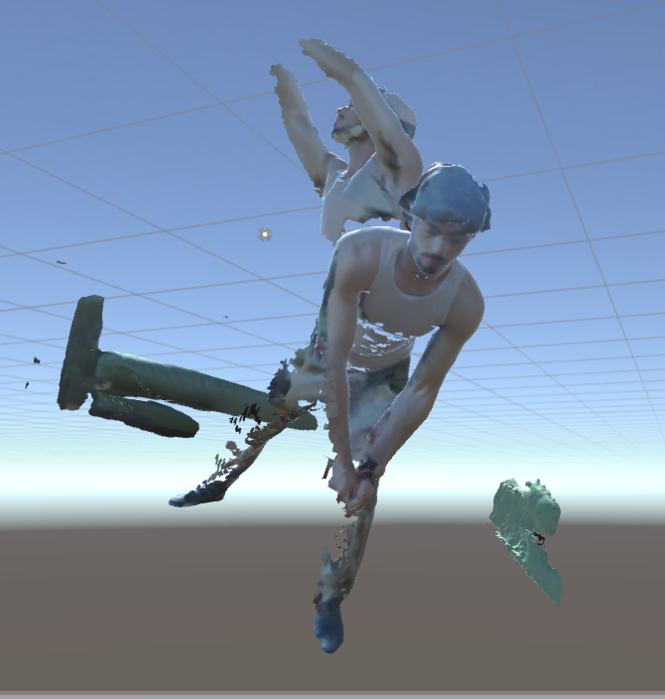Future Now
The IFTF Blog
Some Thoughts on a Philosophy of Virtual Reality
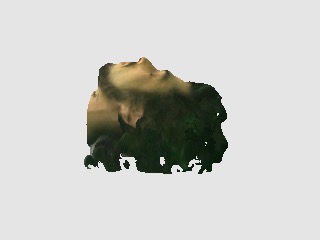
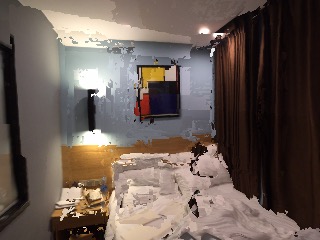
At Institute for the Future we have been experimenting deeply in the frontiers of virtual reality journalism and immersive research environments. A lot of this happens by using small 3D scanners, like the Occipital Structure Sensor, to capture real-world objects and spaces, and then using game design software like Unity to embed them into an interactive world.
One thing that is immediately noticeable about the models is their incompleteness. Because of the limitations of the instruments, software and user, they are imperfect. They are very artistic, painterly, and ethereal.
Although it is tempting to look at this as a limitation, from an artistic perspective it can actually be an asset. It makes them very strange and beautiful and gives us a ready-made concept off of which to build...that these are not real, they are just dreams. In 5 years when I can walk into a room and get a photorealistic model on my cell phone in a couple of seconds, it will be harder to remember this time, when we were first waking up in the virtual world. The models in many ways remind me of the lived experience of remembering...with blurred outlines tugging at the corner of the mind, fighting to become meaningful.
As Merleau-Ponty, perhaps the greatest philosopher of perception once said,
“The phenomenological world is not the bringing to explicit expression of a pre-existing being, but the laying down of being. Philosophy is not the reflection of a pre-existing truth, but, like art, the act of bringing truth into being.”
I think that this "act of bringing truth into being" is something under intense interrogation right now, as it should be. At the center of this interrogation is journalism--an industry that purports to and attempts to convey the current truth. I think that what the new, immersive medium forces us into is a journalistic project that is also a philosophical and artistic project. We are lucky in that we are forced to ask and attempt to answer questions around authentic representation and truth in a new medium that have been laid to rest, or at least over-saturated, in the legacy media with which we are all familiar. Confronted with the inevitability of the structure sensor's imperfect Gaze, we are forced to reflect more deeply on our own.
Of course Merleau-Ponty is not the only philosopher of perception, but his insights have specific relevance to immersive media because of his insistence on vision as an extension of the body...his inflexible dedication to the body as the "general medium for having a world." As Leila Wilson at University of Chicago summarizes:
What distinguishes Merleau-Ponty’s phenomenological investigations from those of other philosophers, such as Sartre and Heidegger, is his insistence on the body as the center of perception and the medium of consciousness. His study of vision as an extension of the corporal shows us that in order for consciousness to unfold into a part of the world—to exist as a flourishing—it must be embodied. To perceive the world and be shaped by it, one must be in and of its flesh. [emphasis added]
This conception of vision as an extension of the body is prescient in that it survives into a world of interactive vision, in which the movements of the individual fundamentally affect that which is seen. This is an aspect of the world, and even so of two dimensional media, but it is an intentional and designed facet of immersive electronic media.
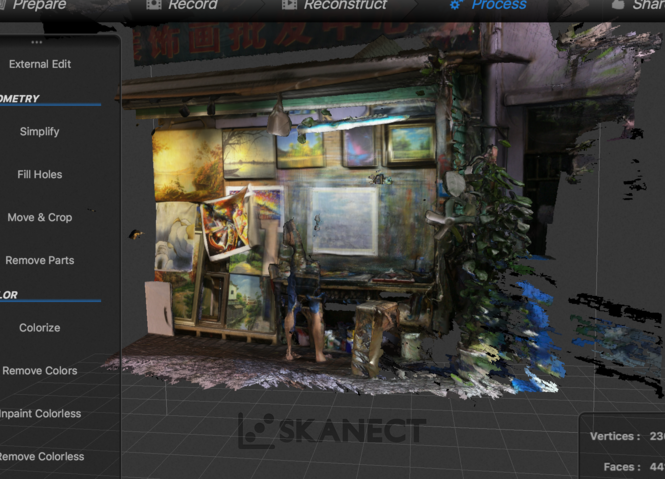
Merleau-Ponty, in Eye and Mind, reserves a special place in civilization for the painter that he does not offer to the scientist. The scientist "manipulates things and gives up living in them," and is restricted to activity "regulated by an experimental control that admits only the most 'worked up' phenomena, more likely produced by the apparatus than recorded by it." This phrase has obvious implications for us using the structure sensor...whose models are partially a recording and partially a production. He points out that "...we cannot imagine how a mind would paint. It is by lending his body to the world that the artist transforms the world into paintings. To understand these transubstantiations we must go back to the working, actual body--not the body as a chunk of space or a bundle of functions but that body which is an intertwining of vision and movement." [emphasis added]
I believe these insights have a direct implication for current virtual reality projects.
If we can admit that we are calling truth into being, as opposed to merely representing it, then we can allow ourselves to use the models as a medium for sculpture and navigation. In other words, in creating an embodied moment of truth for our participants, we may feel free to deviate significantly from our remembered/recorded visual truth. In other words...we can deliberate sacrifice imagined "accuracy" for the sake of the beautiful. This freedom comes from the bravery to describe our work as philosophical and artistic, and defend that framework equally against the primacy of the scientific.
Merleau-Ponty quotes Rodin, “It is the artist who is truthful, while the photograph lies; for, in reality, time never stops.”
Perhaps the problem with journalism, and often, with research in general, which is in danger of reawakening in even greater and more dangerous form in a world of advanced, intelligent simulation, is to work toward replicating the real world with precision instead of accuracy…to work toward, and first believe in, an imagined single truth. Again from Eye and Mind:
"The picture, the actor's mimicry...these are not devices borrowed from the real world in order to refer to prosaic things which are absent. For the imaginary is much nearer to, and farther away from, the actual--nearer because it is in my body as a diagram of the life of the actual, with all its pulp and carnal obverse exposed to view for the first time...and the imaginary is much farther away from the actual because the painting is an analogue or likeness only according to the body."
The ghostliness of the models is so appropriate for Merleau-Ponty, who often described us "haunting" the Other, and being haunted by them. Purportedly he was driven to philosophy by depression in childhood...the long-dead philosophers became his friends and family in place of real ones. What more perfect person to describe the bodily experience of a reality populated by dreams and ghosts?
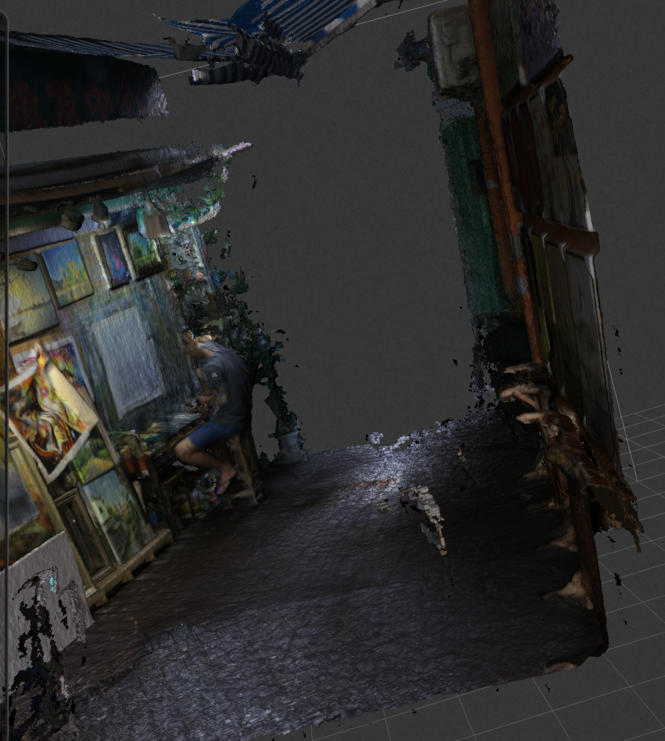
I think that in mixed reality media, right now, we have an enormous opportunity to revel in the imperfections. Because they will be so much harder to detect in a few years, we have the opportunity (and perhaps the responsibility) to create simulacra that are self-aware of their impermanence. So that anyone who passes through them will say that they remember the world before it was so perfect and easy to see. It would be a great misstep to simply show them the circus-trick of creating an imperfect three dimensional mirror, and instead to leave them with the awe that they may be in the presence of a (inexpert, badly made, carried by inappropriate messengers such as ourselves, etc.) new art form, and way of "having a world." If we were honest with ourselves, we might even start with metaphysics.
Quality, light, color, depth, which are there before us, are there only because they awaken an echo in our bodies, and because the body welcomes them!
